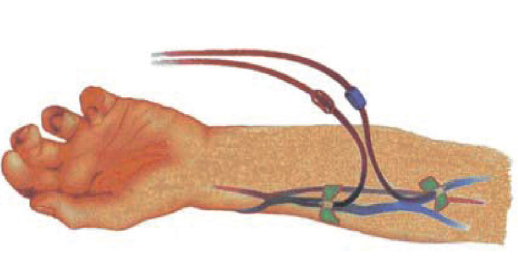Definition
A fistula is surgically created by connecting an artery and a vein in the arm. The vein (superficial, and easily accessible) will therefore be arterialised.
Thus, its size increases, its wall thickens and it becomes visible under the skin. And this facilitates the puncture and the pumping of a sufficient amount of blood (300 ml/ minute).
The passage of blood through the fistula is perceived upon palpation as a quiver (also called «thrill»).
The arteriovenous fistula is the preferred vascular access thanks to:
- its ease of use
- its low rate of infection
- its life time of several years.

Location
The Fistula can be located either on the forearm or on the upper arm. It is preferable to be located on the non-dominant arm, that is to say the left arm for righthanded people, and vice versa, because it is the arm least used in the everyday life.
The Intervention
The intervention is performed under loco-regional anaesthesia (only the arm), in the operating theatre. It lasts about one hour. At any time, you can contact the nurse and advise of any discomfort. In rare case, the intervention is performed under general anaesthesia.
The Hospital Stay
Upon your return from the operating theatre, the nurse will be monitoring your bandage and the proper operation of your fistula. The creation of the latter requires a 24 hours hospitalisation.
The fistula requires a few weeks or even a few months to develop properly, namely to set a flow rate which is sufficient for the haemodialysis. The proper operation of your arteriovenous fistula is a determining factor of the effectiveness of the dialysis. It is therefore very important to take precautions to protect your fistula, in order to keep it in the best possible condition.
Monitoring
Every day:
- Check the vibration of your fistula: you should feel a thrill upon touching
- Note any change: if the vibration is low or absent, if the skin condition is changed (pain, redness, discharge), you must immediately notify your Dialysis Centre.
Precautions To Be Taken
You must avoid:
- wearing a watch, a bracelet or clothing that is too tight on the side of the fistula, so that they do not interfere with the blood flow
- pressing on the fistula arm when you lie down in order to not to apply pressure
- carrying items that are too heavy (suitcases, bags, etc.) with the arm where the fistula is placed
- tattoos and acupuncture
- exposing your fistula to the sun without sunscreen
Do now allow that they measure your blood pressure or draw blood from the arm where the fistula is placed.
Recommendations
The arteriovenous fistula is the preferred vascular access. It is therefore important to protect it against any risk for trauma:
- It is better to wear clothing with long sleeves in order to protect your fistula against injuries that could cause an infection, especially if you have cats, or if you do gardening or craft projects
- Every day, clean the skin and the fistula area with soap and water and apply a moisturising cream
- Before the haemodialysis session, wash the arm where your fistula is located with soap and water and the nurse will disinfect the puncture sites with an antibacterial solution
- After your treatment, bandages are applied over the puncture sites, and they need to be removed 4 to 8 hours afterwards. It is possible that the fistula starts bleeding through the hole of a puncture site, first of all, don’t panic! Just press on this hole with dressing gauze for 10 minutes and change the bandage.
